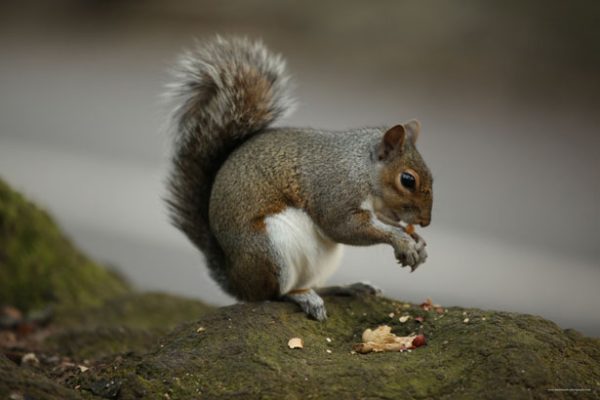Today’s backyard pests were once tasty prey

In neighborhoods like mine in Charlotte, squirrels are generally considered a nuisance. A dearth of predators and an abundance of acorns sustain an unnaturally large population. The scoundrels raid our birdfeeders and pilfer fruits and vegetables from our tiny food plots. (I know a woman who pops them with an airsoft rifle when they perch on her tomato cages. She claims she doesn’t kill them, but they’re easy pickings for the red-tailed hawks.) Even worse, squirrels invade our attics, then proceed to gnaw on wiring, conduit and framing. Once a female has established a warm and cozy nest in the insulation, it’s hard to keep them out.
A few years ago, they got into my husband’s workshop in the Uwharries. After locating a hole near the roof, he and Dad hatched a plan. Marcus climbed a ladder and removed a ceiling tile, and Dad waited outside with his gun. When Marcus stuck his head in the attic, a squirrel scampered toward the hole but didn’t leave. Marcus reached for the air horn he keeps at his shop (in lieu of an unreliable cell phone) to alert us in case of an emergency. When the horn sounded, the squirrel bolted out the hole. Dad had expected it to leap into the willow oak behind the shop. Instead it shot straight out into the air, its legs frantically churning. It literally hit the ground running. It was so shocking – and comical – he didn’t even get off a shot.
Dad was an accomplished squirrel hunter in his adolescence. He had always worked – doing chores around the farm – but this was his first real job that paid a wage, before he was old enough to drive the school bus. He struck a deal with a man in Troy. Mr. Reynolds worked at the county garage. He was fond of squirrel meat, and he paid Dad a dollar for every carcass he brought. This was good money for a crack shot in the Uwharries in the early 1950s.
Imagine the luck of a young man getting paid to spend hours roaming the hills and hollers of the Uwharries – from the county line to Flint Hill Road – with his feist dog, Spot. Dad took Spot farther afield a couple of times, once to a tract of land across the river near New Hope, but there his otherwise fine squirrel dog wouldn’t stay focused on the task at hand. As Dad described it, “he ran around wild.” Away from his regular territory, maybe Spot considered himself off duty and took it as an opportunity to simply enjoy a romp in the woods. For any productive hunting, Dad learned, they had to stick closer to home.
[highlight] “A fat, nut-fed squirrel is better tasting than any meat in the woods.” — Georgia Pellegrini, author of Girl Hunter [/highlight]
Dad developed an intimate knowledge of the woods between Eleazer and Ophir – hundreds, perhaps even thousands, of acres. He learned not only how to find squirrels, but also how to avoid the occasional still. He saw improbable things. Once, down near the headwaters of a branch that flows to Duncombe Creek, he noticed a squirrel sunning itself on a limb high in the canopy. Before he could shoulder his gun, a hawk swooped in, grabbed the squirrel and kept flying. With the squirrel twitching in its talons, the raptor lost its grip. When it hit the forest floor, Dad raced to get there ahead of Spot or the hawk.
When he first started squirrel hunting, he used a .22 until he got his shotgun. He also liked to keep a forked stick next to trees with a cavity in the trunk. He’d twist the stick, and if he was lucky, he extracted a squirrel by the tail. One time, much to his surprise, he pulled out two at once. He quickly gathered his wits before they got away. He took care of one, and Spot took care of the other.

Squirrel would have been an important part of the diet for subsistence farmers in the Uwharries – especially once larger game like black bear and white-tailed deer were extirpated – but even when folks could afford to buy meat at the grocery store, some continued to eat squirrel by choice. Our late neighbors, Bea and Herbert Hardister, hunted in their own side yard, targeting the squirrels that feasted on their pecans. Bea would freeze the meat until she had enough for a pot of squirrel and dumplings. In Girl Hunter, Georgia Pellegrini asserts that “a fat, nut-fed squirrel is better tasting than any meat in the woods.”
And yet squirrel hunting has waned over the past half-century. I can’t help but wonder if that’s due to the resurgence of turkey and white-tailed deer, species long absent from our region. Where’s the allure in stalking a common creature that readily visits our birdfeeders? In a recent article for Wildlife in North Carolina, Bruce Ingram notes that novice and seasoned hunters alike can hone their outdoors skills chasing “silvertails.” Squirrel hunting also lends itself to small, accessible tracts, an aspect that shouldn’t be discounted in our increasingly urban Piedmont. These days, it’s mighty tough for a boy and his dog to ramble across an unfettered landscape in pursuit of squirrels, but perhaps this tradition will be reinvented as devotees of the local foods movement take to suburban woodlots in their quest for quality meat.
Ruth Ann Grissom is a writer and conservationist who divides her time between Charlotte and the Uwharries.